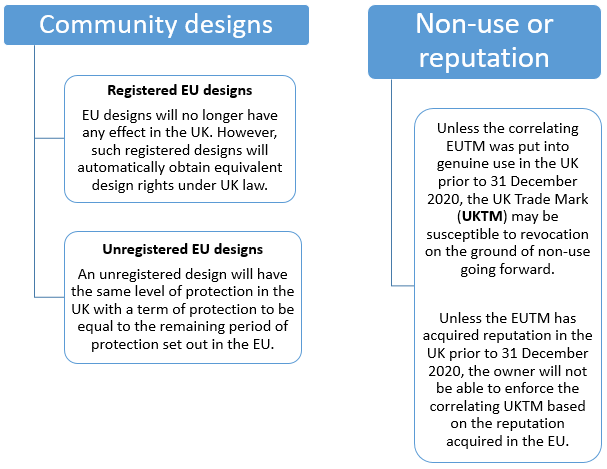- within Law Practice Management, Consumer Protection and Finance and Banking topic(s)
- with Senior Company Executives, HR and Finance and Tax Executives
- with readers working within the Property industries
The UK is officially leaving the European Union (EU) after 47 years, but what does this mean for your intellectual property rights in Europe, such as registered trade marks, pending application and designs? We set out a summary below outlining the main effects to be cognisant of going forward.
Transition period
A transition period has been put in place which allows the UK to remain part of the EU intellectual property system until 31 December 2020 (Transition Period). This means that the laws governing intellectual property in the EU will continue to apply to the UK for the Transition Period. However, whilst the laws will continue to be applicable, the UK will have no further say in any European policy or change in legislation.
In summary, whether you have applied directly via the EU, or through an international platform, (such as the Madrid protocol) you should be aware of the following implications post 31 December 2020:
Registered trade marks and designs
Until the end of the Transition Period, there will be no changes to EU trade mark applications, design applications, registrations or proceedings. However, once the Transition Period expires, EU trade marks will no longer have any effect in the UK.
From 1 January 2021, all registered EU trade marks will be automatically granted the equivalent rights to those that currently exist within the UK, at no charge.
Should you be the registered owner of any existing EU trade mark under the Madrid Protocol (which includes the EU as a relevant designation), your marks will also be automatically granted the equivalent UK trade mark rights for the registered period.
It is important to note that any newly registered UK trade marks will require a separate renewal application with the Intellectual Property office in the UK once expired. Therefore, renewal fees will become payable in both the EU and the UK.
In order to avoid any negative outcomes, it is essential to check all newly registered corresponding UK trade marks to ensure that the details have been accurately transferred across from the EUTM registration.
Pending applications for EU trade marks
Until the end of the Transition Period on 31 December 2020, no changes are required.
From 1 January 2021, any pending EU trade marks will not be automatically granted equivalent rights in the UK as per registered trade marks. Should you have any pending applications, you will have the option to register an equivalent UK trade mark within nine months from 31 December 2020. If you proceed with this approach, you will have the opportunity to claim priority from the earlier filing date in Europe.
To avoid potentially missing the nine month cut-off date (being 30 September 2021), you may wish to consider filing separate corresponding UK trade marks now, at the same time as filing any EU trade marks. This will avoid any risk where your EU trade mark is not registered before the end of the Transition Period.
Domain names
Throughout the Transition Period, no changes are required.
Upon expiration of the Transition Period, any .eu domain names that are registered in the name of an entity that is not an EU entity (including a UK entity) will be automatically withdrawn.
We recommend changing the registrant details to an EU entity before the end of the Transition Period, if practical.
Taking action
In order to successfully maintain the protection of your intellectual property, whether it be pending or registered trade marks, designs, or .eu domain names, the following steps are recommended:
- conduct a portfolio review and determine what existing and pending intellectual property you currently hold within the EU
- determine what actions are required of you in relation to such intellectual property
- update all internal databases with the correlating changes
- diarise the nine month deadline (being 30 September 2021) in relation to all of your pending European trade mark applications
- if possible, start to build a reputation in your marks or designs throughout the UK, prior to the end of the Transition Period if you currently do not use or promote such marks or designs in the UK but wish to retain protection going forward.
This publication does not deal with every important topic or change in law and is not intended to be relied upon as a substitute for legal or other advice that may be relevant to the reader's specific circumstances. If you have found this publication of interest and would like to know more or wish to obtain legal advice relevant to your circumstances please contact one of the named individuals listed.
[View Source]


